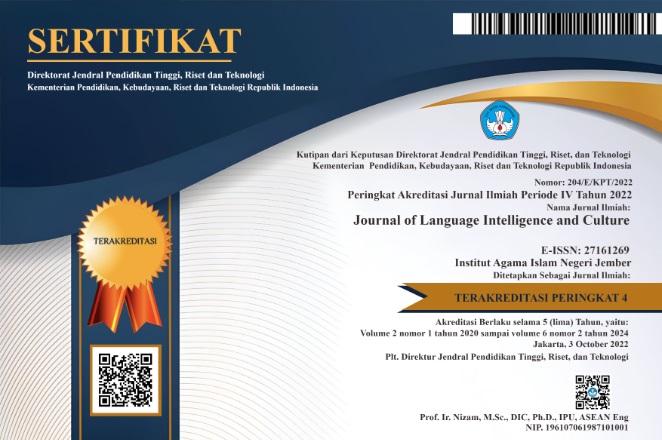Analysis of Higher Order Thinking Skills (HOTS) in Online Learning by English Teacher
DOI:
https://doi.org/10.35719/jlic.v5i1.114Keywords:
Higher order thinking skills (HOTS), online learning, EnglishAbstract
HOTS is a skill that is needed in the 21st century. This skill requires students to be able to think creatively and think critically in facing future challenges so teachers must be able to teach students through asking questions that demand HOTS skills, but during pandemic covid 19 face-to-face learning has shifted to online learning which makes teachers have to be able to change HOTS learning be an online mode. This study aims to analyze the questions and task given by the teacher during HOTS-based online learning to students. The method used in this research is qualitative by using a descriptive approach. Data is obtained through documentation by analyzing the content of the questions. The data were analyzed through three stages, namely data reduction, data display and data conclusion. The results of the study show that the application of HOTS in learning has a significant impact on providing students' critical reasoning and creativity abilities. In addition, during online learning the teacher provides a number of questions related to HOTS which are at C4, C5 and C6 levels so that students are expected to have better abilities during English learning.
References
Anasy, Z. (2016). Hots (Higher Order Thinking Skill) in reading exercise. TARBIYA: Journal of Education in Muslim Society, 3(1), 51–63. https://doi.org/10.15408/tjems.v3i1.3886
Anderson, L. W., Krathwohl, D. R., Airasian, P. W., Cruikshank, K. A., Pintrich, P. R., Raths, J., &
Wittrock, M. C. (2001). A taxonomy for Learning, Teaching, and Assessing: A Revision of Bloom’s Taxonomy of Educational Objectives. Addison Wesley Longman, Inc.
Anderson, B. (2007). Pedagogical rules and their relationship to frequency in the input: observational and empirical data from L2 French. Applied Linguistics, 28(2), 286–308. https://doi.org/http://dx.doi.org/10.1093/applin/amm015
Armala, I., Fauzia, E., & Asib, A. (2019). Pre-service English teachers’ perception on higher order thinking skills (HOTS) in English language teaching. Journal of Language Intelligence and Culture, 1(01). https://doi.org/10.35719/jlic.v1i01.16
Brookhart, S. M. (2010). How to asses high order thinking skills in your classroom. ASDC Member Book.
Cresswell. (2013). Research design: Qualitative, quantitative, and mixed methods approaches. Sage Publication.
Destianingsih, A., & Satria, A. (2020). Investigating students’ needs for effective English online learning during covid-19 for Polbeng students. 7(2), 147–153. https://doi.org/https://doi.org/10.31849/elt-lectura.v7i2.4657
Djami, C. B. N., & Kuswandono, P. (2020). Teachers’ strategies to implement higher-order thinking skills in English instruction. Metathesis: Journal of English Language, Literature, and Teaching, 4(1). https://doi.org/10.31002/metathesis.v4i1.2048
Faradella, N. E. (2022). Students’ higher-order thinking skills: constructing best practices in teaching English during online learning. Erudita: Journal of English Language Teaching, 2(1), 38–49. https://doi.org/10.28918/erudita.v2i1.5350
Hemas, M. D. A., Wedhanti, N. K., & Juniarta, P. A. K. (2021). Analysis of higher order thinking skills in English lesson plans. Thinking Skills and Creativity Journal, 4(2). https://doi.org/10.23887/tscj.v4i2.36999
Krathwohl, A. and. (2002). ( A REVISION OF BLOOM ’ S TAXONOMY ). Theory into Practice, 41(4), 212–219.
Krippendorff, K. (2004). Reliability in content analysis some common misconceptions and recommendations. Human Communication Research, 30(3), 411–433. https://doi.org/https://doi.org/10.1111/j.1468-2958.2004.tb00738.x
Margana, M., & Widyantoro, A. (2017). Developing English textbooks oriented to higher order thinking skills for students of vocational high schools in Yogyakarta. Journal of Language Teaching and Research, 8(1), 26. https://doi.org/doi.org/10.17507/jltr.0801.04
Miles, M. B., Huberman, A. M., & Saldana, J. (2013). Qualitative data analysis: A methods sourcebook. Sage Publications Incorporated. https://doi.org/https://doi.org/10.1080/10572252.2015.975966
Narwianta, N., Bharati, D. A. L., & Rukmini, D. (2019). The evaluation of higher order thinking skills in English school nationally standardized examination at state senior high school 6 Semarang. English Education Journal, 9(3). https://doi.org/10.15294/eej.v9i3.30937
Pratama, Y. A., & Dewi, L. (2022). Online learning through the RADEC model to increase HOTS of elementary school students in the time of the covid-19 pandemic. PrimaryEdu: Journal of Primary …, 6(2), 18–19. http://e-journal.stkipsiliwangi.ac.id/index.php/primaryedu/article/view/3034%0Ahttp://ejournal.stkipsiliwangi.ac.id/index.php/primaryedu/article/viewFile/3034/1462
Prayudha.S, J. (2023). The use of TPACK approach in learning process. 2nd International Conference on Education Faculty of Education and Teacher Training UIN Sulthan Thaha Saifuddin Jambi, 2, 66–69.
Prayudha, J. (2022). EFL students’ perception on the use of social media platforms as learning tools. JETLi: Journal of English Teaching and Linguistics, 3(1), 1–9. https://doi.org/10.55616/jetli.v3i1.226
Prayudha, J. (2022). Using voice note media to build Efl students’ confidence in English speaking skill. The 4th TEYLIN International Conference, August, 180–189.
Prayudha, J. S. (2021). Students' problems face in online learning amidt pandemic Acitya: Journal of Teaching & Education, 3(2), 2021. http://journals.umkt.ac.id/index.php/acitya
Prayudha S., J. (2021). Video based learning as a media for teaching English during pandemic covid-19. Journal of Language Intelligence and Culture, 2(1), 1–11. https://doi.org/10.35719/jlic.v2i1.53
Putri, R. N., & Sulityaningrum, S. D. (2021). Incorporating higher-order thinking skills in English lesson plans for senior high school. Celtic: A Journal of Culture, English Language Teaching, Literature and Linguistics, 8(2).
Rahmayanti, H., Ichsan, I. Z., Azwar, S. A., Purwandari, D. A., Pertiwi, N., Singh, C. K. S., & Gomes, P. W. P. (2020). Difmol: Indonesian students’ Hots and environmental education model during covid-19. Journal of Sustainability Science and Management, 15(7). https://doi.org/https://doi.org/10.46754/jssm.2020.10.002
Setyowati, R., Sarwanto, & M. (2021). How students’s higher order thinking skills through e-learning during the covid-19 pandemic? What does it have to do with university? IOP Conference Series: Earth and Environmental Science, 18(8). https://doi.org/https://doi.org/10.1088/1742-6596/1808/1/012032
Singh, C. K. S., Singh, T. S. M., Ja’afar, H., Tek, O. E., Kaur, H., Mostafa, N. A., & Yunus, M. M. (2020). Teaching strategies to develop higher order thinking skills in english literature. International Journal of Innovation, Creativity and Change, 11(8).
Suardamayasa, P. (2022). Teachers’ ability to apply higher-order thinking skills in English lesson plan. Journal of Educational Study, 2(1). https://doi.org/10.36663/joes.v2i1.254
Sugiyono. (2014). Memahami Penelitian Kualitatif. Alfabeta.
Widyastuti, N. W. S. (2022). The implementation of HOTS-based English learning in junior high school during online classes. Journal of Educational Study, 2(3), 215–225. https://doi.org/10.36663/joes.v2i3.381
Downloads
Published
How to Cite
Issue
Section
License
Copyright (c) 2023 Nabila Maratus Salihah, Joko Prayudha S

This work is licensed under a Creative Commons Attribution-ShareAlike 4.0 International License.













